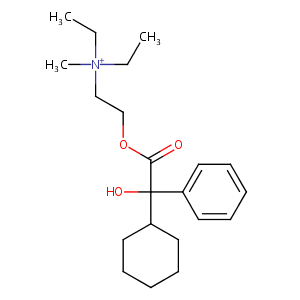Details of the Drug
General Information of Drug (ID: DMMQHOZ)
| Drug Name |
Oxyphenonium
|
||||||||||||||||||||||
|---|---|---|---|---|---|---|---|---|---|---|---|---|---|---|---|---|---|---|---|---|---|---|---|
| Synonyms |
Argicillin; Atrenyl; Hydroxymethylgramicidin; Methacin; Methocidin; Methocidine; Methocidinum; Metocidina; Oxiphenonum; Spastrex;Oxyphenonium Chloride; Oxyphenonium Iodide; Methocidin [DCF:INN]; Methocidine [INN-French]; Methocidinum [INN-Latin]; Metocidina [INN-Spanish]; [2-(2-Cyclohexyl-2-hydroxy-2-phenyl-acetoxy)-ethyl]-diethyl-methyl-ammonium; 2-((Cyclohexylhydroxyphenylacetyl)oxy)-N,N-diethyl-N-methylethanaminium; 2-(2-cyclohexyl-2-hydroxy-2-phenylacetyl)oxyethyl-diethyl-methylazanium; 2-[2-cyclohexyl(hydroxy)phenylacetoxy]-n,n-diethyl-n-methylethanaminium
|
||||||||||||||||||||||
| Indication |
|
||||||||||||||||||||||
| Therapeutic Class |
Parasympatholytics
|
||||||||||||||||||||||
| Drug Type |
Small molecular drug
|
||||||||||||||||||||||
| Structure |
 |
||||||||||||||||||||||
| 3D MOL | 2D MOL | ||||||||||||||||||||||
| #Ro5 Violations (Lipinski): 0 | Molecular Weight (mw) | 348.5 | |||||||||||||||||||||
| Logarithm of the Partition Coefficient (xlogp) | 4.1 | ||||||||||||||||||||||
| Rotatable Bond Count (rotbonds) | 9 | ||||||||||||||||||||||
| Hydrogen Bond Donor Count (hbonddonor) | 1 | ||||||||||||||||||||||
| Hydrogen Bond Acceptor Count (hbondacc) | 3 | ||||||||||||||||||||||
| ADMET Property |
|
||||||||||||||||||||||
| Chemical Identifiers |
|
||||||||||||||||||||||
| Cross-matching ID | |||||||||||||||||||||||
Molecular Interaction Atlas of This Drug
 Drug Therapeutic Target (DTT) |
|
||||||||||||||||||||||||||
|---|---|---|---|---|---|---|---|---|---|---|---|---|---|---|---|---|---|---|---|---|---|---|---|---|---|---|---|
 Drug Transporter (DTP) |
|
||||||||||||||||||||||||||
| Molecular Interaction Atlas (MIA) | |||||||||||||||||||||||||||
Molecular Expression Atlas of This Drug
| The Studied Disease | Visceral spasms | |||||||||||||||||||||||||||||
|---|---|---|---|---|---|---|---|---|---|---|---|---|---|---|---|---|---|---|---|---|---|---|---|---|---|---|---|---|---|---|
| ICD Disease Classification | MD81.4 | |||||||||||||||||||||||||||||
|
||||||||||||||||||||||||||||||
| Molecular Expression Atlas (MEA) | ||||||||||||||||||||||||||||||
References
